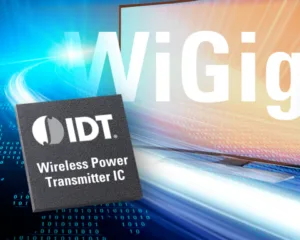Integrated Device Technology, Inc. (IDT®) today announced its collaboration with Blu Wireless Technology to demonstrate integrated wireless charging with ultra-fast 60 GHz WiGig® data transmission, a combination that will enable consumers to charge their phones and tablets while streaming the highest quality 4K HD video and photos to their televisions and computers—all without the need for cords.
The collaboration will team IDT’s expertise in wireless power with Blu Wireless’s know-how in WiGig, which allows devices to communicate wirelessly at multi-gigabit speeds. The single-module technology targeted by the companies will, for example, enable consumers to wirelessly charge their devices while cordlessly transmitting uncompressed video of 1080p directly to their HDTV.
WiGig technology uses the 60 GHz band to deliver 7 GHz bandwidth. A synchronization of data on a portable device that today would take two hours and use up nearly a third of a battery’s charge can be completed, with WiGig, in just 45 seconds and consume only 2 percent of the charge. IDT’s semiconductors are enabling wireless charging today in a quickly growing esolcosystem of applications that includes smartphones and accessories, wearables and furniture.
“Growing market demands are requiring easier and faster ways to move video and massive multimedia files in real time without depleting a device’s battery,” said Sailesh Chittipeddi, vice president of global operations and chief technology officer at IDT. “The marriage of wireless charging and WiGig technology answers that call, providing a unique user experience that meets the expectations of today’s consumer.”
“Between Blu Wireless’ expertise in WiGig and IDT’s in wireless power, we are developing a solution that keeps pace with demands in an age of massive multimedia content,” said Mark Barrett, chief marketing officer at Blu Wireless. “The unique combination of low-profile 60 GHz phased array technology and wireless charging capabilities supports the increased data and ease-of-use demands of mobile users.”

